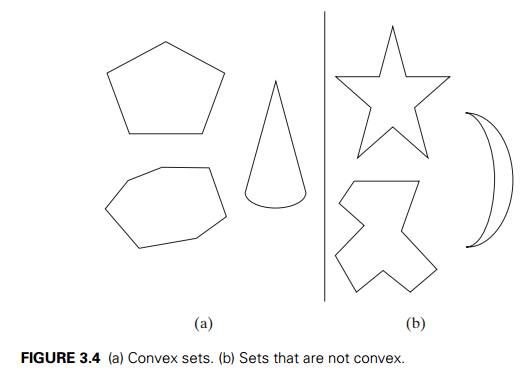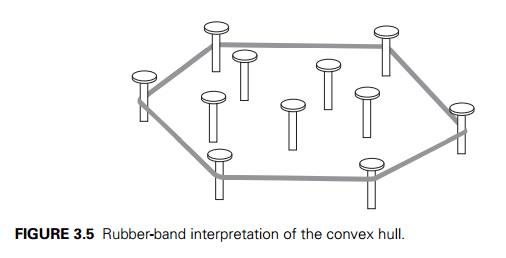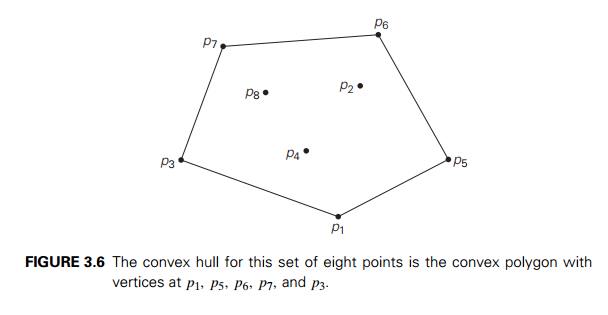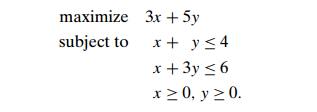Chapter: Introduction to the Design and Analysis of Algorithms : Brute Force and Exhaustive Search
Closest-Pair and Convex-Hull Problems by Brute Force
Closest-Pair
and Convex-Hull Problems by Brute Force
In this
section, we consider a straightforward approach to two well-known prob-lems
dealing with a finite set of points in the plane. These problems, aside from
their theoretical interest, arise in two important applied areas: computational
ge-ometry and operations research.
The
closest-pair problem calls for finding the two closest points in a set of n points. It is the simplest of a
variety of problems in computational geometry that deals with proximity of
points in the plane or higher-dimensional spaces. Points in question can
represent such physical objects as airplanes or post offices as well as
database records, statistical samples, DNA sequences, and so on. An air-traffic
controller might be interested in two closest planes as the most probable
collision candidates. A regional postal service manager might need a solution
to the closest-pair problem to find candidate post-office locations to be
closed.
One of
the important applications of the closest-pair problem is cluster analy-sis in
statistics. Based on n data
points, hierarchical cluster analysis seeks to orga-nize them in a hierarchy of
clusters based on some similarity metric. For numerical data, this metric is
usually the Euclidean distance; for text and other nonnumerical data, metrics
such as the Hamming distance (see Problem 5 in this section’s ex-ercises) are used.
A bottom-up algorithm begins with each element as a separate cluster and merges
them into successively larger clusters by combining the closest pair of
clusters.
For
simplicity, we consider the two-dimensional case of the closest-pair prob-lem.
We assume that the points in question are specified in a standard fashion by
their (x, y) Cartesian coordinates and that
the distance between two points pi(xi, yi) and pj (xj , yj ) is the
standard Euclidean distance

The
brute-force approach to solving this problem leads to the following ob-vious
algorithm: compute the distance between each pair of distinct points and find a
pair with the smallest distance. Of course, we do not want to compute the
distance between the same pair of points twice. To avoid doing so, we consider
only the pairs of points (pi,
pj ) for
which i < j .
Closest-Pair and Convex-Hull Problems by
Brute Force
Pseudocode
below computes the distance between the two closest points; getting the closest
points themselves requires just a trivial modification.
ALGORITHM BruteForceClosestPair(P )
//Finds
distance between two closest points in the plane by brute force
//Input:
A list P of n
(n ≥ 2) points p1(x1, y1), . . . , pn(xn, yn)
//Output: The distance between the closest pair of points
d ←
∞
for i ← 1 to n − 1 do
for j ← i + 1 to n do
d ← min(d, sqrt((xi − xj )2 + (yi
− yj )2)) //sqrt is square
root
return d
The basic
operation of the algorithm is computing the square root. In the age of
electronic calculators with a square-root button, one might be led to believe
that computing the square root is as simple an operation as, say, addition or
multiplication. Of course, it is not. For starters, even for most integers,
square roots are irrational numbers that therefore can be found only
approximately. Moreover, computing such approximations is not a trivial matter.
But, in fact, computing square roots in the loop can be avoided! (Can you think
how?) The trick is to realize that we can simply ignore the square-root
function and compare the values (xi
− xj )2 + (yi
− yj )2 themselves. We can do this
because the smaller a number of which we
take the square root, the smaller its square root, or, as mathematicians say,
the square-root function is strictly increasing.
Then the
basic operation of the algorithm will be squaring a number. The number of times
it will be executed can be computed as follows:

Of
course, speeding up the innermost loop of the algorithm could only de-crease
the algorithm’s running time by a constant factor (see Problem 1 in this
section’s exercises), but it cannot improve its asymptotic efficiency class. In
Chap-ter 5, we discuss a linearithmic algorithm for this problem, which is
based on a more sophisticated design technique.
Convex-Hull
Problem
On to the
other problem—that of computing the convex hull. Finding the convex hull for a
given set of points in the plane or a higher dimensional space is one of the
most important—some people believe the most important—problems in
com-putational geometry. This prominence is due to a variety of applications in
which this problem needs to be solved, either by itself or as a part of a
larger task. Sev-eral such applications are based on the fact that convex hulls
provide convenient approximations of object shapes and data sets given. For
example, in computer an-imation, replacing objects by their convex hulls speeds
up collision detection; the same idea is used in path planning for Mars mission
rovers. Convex hulls are used in computing accessibility maps produced from
satellite images by Geographic Information Systems. They are also used for
detecting outliers by some statisti-cal techniques. An efficient algorithm for
computing a diameter of a set of points, which is the largest distance between
two of the points, needs the set’s convex hull to find the largest distance
between two of its extreme points (see below). Finally, convex hulls are
important for solving many optimization problems, because their extreme points
provide a limited set of solution candidates.
We start
with a definition of a convex set.
DEFINITION
A set of
points (finite or infinite) in the plane is called convex if for any two points p and q in the
set, the entire line segment with the endpoints at p and q belongs to the set.
All the
sets depicted in Figure 3.4a are convex, and so are a straight line, a
triangle, a rectangle, and, more generally, any convex polygon,1 a
circle, and the entire plane. On the other hand, the sets depicted in Figure
3.4b, any finite set of two or more distinct points, the boundary of any convex
polygon, and a circumference are examples of sets that are not convex.
Now we
are ready for the notion of the convex hull. Intuitively, the convex hull of a
set of n points in the plane is the
smallest convex polygon that contains all of them either inside or on its
boundary. If this formulation does not fire up your enthusiasm, consider the
problem as one of barricading n sleeping
tigers by a fence of the shortest length. This interpretation is due to D.
Harel [Har92]; it is somewhat lively, however, because the fenceposts have to
be erected right at the spots where some of the tigers sleep! There is another,
much tamer interpretation of this notion. Imagine that the points in question
are represented by nails driven into a large sheet of plywood representing the
plane. Take a rubber band and stretch it to include all the nails, then let it
snap into place. The convex hull is the area bounded by the snapped rubber band
(Figure 3.5).
A formal
definition of the convex hull that is applicable to arbitrary sets, including
sets of points that happen to lie on the same line, follows.
DEFINITION
The convex
hull of a set S of points is the smallest convex
set
containing
S. (The “smallest” requirement
means that the convex hull of S must be
a subset of any convex set containing S.)
If S is convex, its convex hull is
obviously S itself. If S is a set of two points, its
convex hull is the line segment connecting these points. If S is a set of three


points
not on the same line, its convex hull is the triangle with the vertices at the
three points given; if the three points do lie on the same line, the convex
hull is the line segment with its endpoints at the two points that are farthest
apart. For an example of the convex hull for a larger set, see Figure 3.6.
A study
of the examples makes the following theorem an expected result.
THEOREM The
convex hull of any set S of n > 2 points
not all on the same line is a convex polygon with the
vertices at some of the points of S. (If all
the points do lie on the same line, the polygon degenerates to a line segment
but still with the endpoints at two points of S.)

The convex-hull
problem is the problem of constructing the convex hull for a given set S of n points.
To solve it, we need to find the points that will serve as the vertices of the
polygon in question. Mathematicians call the vertices of such a polygon
“extreme points.” By definition, an extreme point of a convex set is a
point of this set that is not a middle point of any line segment with endpoints
in the set. For example, the extreme points of a triangle are its three
vertices, the extreme points of a circle are all the points of its
circumference, and the extreme points of the convex hull of the set of eight
points in Figure 3.6 are p1, p5, p6, p7,
and p3.
Extreme
points have several special properties other points of a convex set do not
have. One of them is exploited by the simplex method, a very important
algorithm discussed in Section 10.1. This algorithm solves linear programming
problems, which are problems of finding a minimum or a maximum of a linear
function of n variables subject to linear
constraints (see Problem 12 in this section’s exercises for an example and
Sections 6.6 and 10.1 for a general discussion). Here, however, we are
interested in extreme points because their identification solves the
convex-hull problem. Actually, to solve this problem completely, we need to
know a bit more than just which of n points
of a given set are extreme points of the set’s convex hull: we need to know
which pairs of points need to be connected to form the boundary of the convex
hull. Note that this issue can also be addressed by listing the extreme points
in a clockwise or a counterclockwise order.
So how
can we solve the convex-hull problem in a brute-force manner? If you do not see
an immediate plan for a frontal attack, do not be dismayed: the convex-hull
problem is one with no obvious algorithmic solution. Nevertheless, there is a
simple but inefficient algorithm that is based on the following observation
about line segments making up the boundary of a convex hull: a line segment
connecting two points pi and pj of a set
of n points is a part of the convex
hull’s boundary if and only if all the other points of the set lie on the same
side of the straight line through these two points.2 (Verify this
property for the set in Figure 3.6.) Repeating this test for every pair of
points yields a list of line segments that make up the convex hull’s boundary.
A few
elementary facts from analytical geometry are needed to implement this
algorithm. First, the straight line through two points (x1, y1), (x2, y2) in the coordinate plane can be
defined by the equation
ax + by = c,
where a = y2 − y1, b = x1 − x2, c = x1y2 − y1x2.
Second,
such a line divides the plane into two half-planes: for all the points in one
of them, ax + by > c, while for all the points in the
other, ax + by < c. (For the points on the line
itself, of course, ax + by = c.) Thus,
to check whether certain points lie on the same side of the line, we can simply
check whether the expression ax + by − c has the
same sign for each of these points. We leave the implementation details as an
exercise.
What is
the time efficiency of this algorithm? It is in O(n3): for each of n(n − 1)/2 pairs of distinct points, we
may need to find the sign of ax + by − c for each
of the other n − 2
points. There are much more efficient algorithms for this important problem,
and we discuss one of them later in the book.
Exercises
3.3
1. Assuming that sqrt takes about 10 times longer than each of the other oper-ations in the innermost loop of BruteForceClosestPoints, which are assumed to take the same amount of time, estimate how much faster the algorithm will run after the improvement discussed in Section 3.3.
2. Can you design a more efficient algorithm than the one based on the brute-force strategy to solve the closest-pair problem for n points x1, x2, . . . , xn on the real line?
3. Let x1 < x2 < . . . < xn be real numbers representing coordinates of n villages located along a straight road. A post office needs to be built in one of these villages.
Design an efficient algorithm to find the
post-office location minimizing the average distance between the villages and
the post office.
Design an efficient algorithm to find the
post-office location minimizing the maximum distance from a village to the post
office.
4. a. There are several alternative ways to define a distance between two points p1(x1, y1) and p2(x2, y2) in the Cartesian plane. In particular, the Manhat-tan distance is defined as
dM (p1, p2) =
|x1 − x2| + |y1 − y2|.
Prove
that dM
satisfies the following axioms, which every distance function must satisfy:
dM
(p1, p2) ≥ 0 for any
two points p1 and
p2, and dM (p1, p2) = 0 if and only if p1 = p2
dM
(p1, p2) = dM
(p2, p1)
dM
(p1, p2) ≤ dM
(p1, p3) + dM
(p3, p2) for any p1, p2, and
p3
Sketch all the points in the Cartesian plane whose
Manhattan distance to the origin (0, 0) is equal
to 1. Do the same for the Euclidean distance.
True or false: A solution to the closest-pair
problem does not depend on which of the two metrics—dE
(Euclidean) or dM
(Manhattan)—is used?
5. The Hamming distance between two strings of equal length is defined as the number of positions at which the corresponding symbols are different. It is named after Richard Hamming (1915–1998), a prominent American scientist and engineer, who introduced it in his seminal paper on error-detecting and error-correcting codes.
Does the Hamming distance satisfy the three axioms
of a distance metric listed in Problem 4?
What is the time efficiency class of the
brute-force algorithm for the closest-pair problem if the points in question
are strings of m symbols
long and the distance between two of them is measured by the Hamming distance?
6. Odd pie fight There are n ≥ 3 people positioned on a field (Euclidean plane) so that each has a unique nearest neighbor. Each person has a cream pie. At a signal, everybody hurls his or her pie at the nearest neighbor. Assuming that n is odd and that nobody can miss his or her target, true or false: There always remains at least one person not hit by a pie. [Car79]
7. The
closest-pair problem can be posed in the k-dimensional
space, in which the Euclidean distance between two points p (x1, . . . , xk) and p (x1 , . . . , xk ) is defined as

What is
the time-efficiency class of the brute-force algorithm for the k-dimensional closest-pair
problem?
8. Find the convex hulls of the following sets and
identify their extreme points (if they have any):
a. a line
segment
a square
the boundary of a square
a straight line
9. Design a linear-time algorithm to determine two
extreme points of the convex hull of a given set of n
> 1 points in the plane.
10. What modification needs to be made in the
brute-force algorithm for the convex-hull problem to handle more than two
points on the same straight line?
11. Write a program implementing the brute-force
algorithm for the convex-hull problem.
12. Consider the following small instance of the linear
programming problem:

Sketch, in the Cartesian plane, the problem’s feasible
region, defined as the set of points satisfying all the problem’s
constraints.
Identify the region’s extreme points.
Solve this optimization problem by using the
following theorem: A linear programming problem with a nonempty bounded
feasible region always has a solution, which can be found at one of the extreme
points of its feasible region.
Related Topics